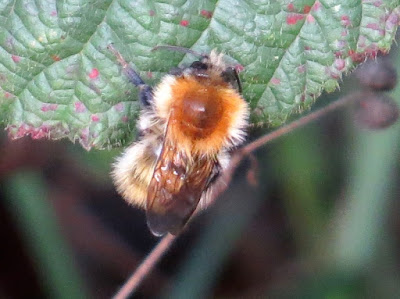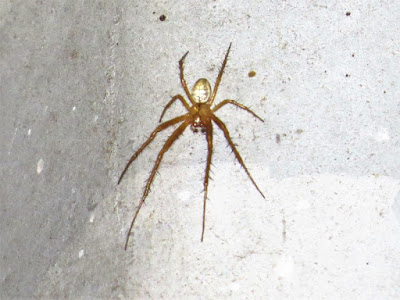9.0°C > 13.0°C: Initially broken cloud with light sprinkles of rain. Dryer with less cloud and more sun later. Light / moderate W wind. Good visibility.
Sunrise: 07:12 BST
* = a photo today.
Priorslee Lake: 05:47 – 09:34
(208th visit of the year)
Always hard to prove something is not present. I did not hear anything of yesterday's Cetti's Warbler. But as it was so vocal yesterday I strongly suspect it has gone.
Bird notes:
- An adult Mute Swan flew NW overhead at 07:20 apparently without even casting a glance at the water.
- A single Canada Goose was heard to arrive and then almost immediately depart at 06:05. It clearly has better night vision than I do.
- Coot number declining after last week's build-up.
- 326 Lesser Black-backed Gulls were counted flying from the N / NW between 06:35 and 06:50. They were arriving from a greater height than recently and swirling, circling down to the water where most stayed a very short while – there were just three on the water at 07:30. I am sure that some of the birds flew directly over, though it was impossible to sort them out from the swirling arriving and departing birds.
- Later more large gulls transitioned, mainly from E to W, stopping off at the lake: I logged 62 Lesser Black-backs, seven Herring Gulls and a third winter Yellow-legged Gull.
- Just two Lesser Black-backed Gulls passed over showing no suggesting they were going to alter course to partake of the delicious water on offer.
- It was useful that the gulls were arriving from high up otherwise I might have missed the equally high-flying group of 114 Rooks. The Jackdaws were mainly in two large groups of c.110 and 84
- Just one Chiffchaff which sang briefly. Did not hear any calls.
- A male Blackcap seen. A calling bird nearby a few minutes later may or may not have been the same individual. In any event it is my first October log of this species here.
- A Yellow Wagtail was an unlikely fly-over on this date. Seen as well as heard.
Birds noted flying over / near here:
- 1 Mute Swan
- 5 Greylag Geese (trio and single outbound; single inbound)
- 11 Canada Geese (two groups outbound)
- 7 Cormorants (five SW; two E)
- ?? Lesser Black-backed Gulls (see notes)
- 54 Wood Pigeons
- c.229 Jackdaws
- 121 Rooks
- 1 Yellow Wagtail
- 8 Pied Wagtails
- 3 Skylarks
Count of warblers logged (singing birds in brackets):
- 1 (1) Chiffchaff
- 1 (0) Blackcap (see notes)
Counts from the lake area:
- 2 + 5 Mute Swans
- 1 Canada Goose
- 10 (7♂) Mallard
- 1 Grey Heron
- 1 + 1 Little Grebe
- 18 Great Crested Grebes
- 5 Moorhens
- 116 Coots
- >75 Black-headed Gulls
- >300 Lesser Black-backed Gulls (see notes)
- >7 Herring Gulls
- 1 Yellow-legged Gull
Birds on playing fields c.07:15:
[Wood Pigeons and Magpies excluded]
- c.150 Black-headed Gulls on the academy playing field
then
- 116 Black-headed Gulls on the football field: 101 of these had come from the academy with 15 new arrivals from the W
On / around the street lights etc. pre-sunrise:
- 1 Common Green Lacewing (Chrysoperia carnea)
- 1 Larinioides sclopetarius (Orb-web spider)
- 1 Metellina segmentata (Orb-web spider)
- 1 Leiobunum blackwalli harvestman
- 1 Opilio canestrinii harvestman
Insects / other things etc. noted later: just
- Common Carder Bee (Bombus pascuorum)
Mammals
- 2 Grey Squirrels
The fly-over adult Mute Swan. Seems not to have any rings.
The leggy nature of this Leiobunum rotundum-type harvestman is accentuated by the shadow from the flash
It was sufficiently low down on the lamp pole that I could get in close to the eyes. Even now I cannot be 100% sure but I think there is a pale rim around the eye which means this is L. blackwalli.
(Ed Wilson)
------------------------------------------------------------------------------------------------------
The Flash: 09:37 – 10:36
(192nd visit of the year)
Bird notes:
- All the Mute Swan cygnets went for a fly together with two completing a second lap..
- Four of the fly-over Jackdaws joined in with a local Carrion Crow to 'assist' the Common Buzzard in its way.
- A Grey Wagtail here again.
Birds noted flying over / near The Flash:
- 1 Common Buzzard
- 2 Wood Pigeons
- 7 Jackdaws
Count of warblers logged (singing birds in brackets):
- 1 (1) Chiffchaff
Counts from the water:
- 3 + 7 (1 brood) Mute Swans
- 2 Greylag Geese
- 20 Canada Geese
- 34 (23♂) Mallard
- 82 (?♂) Tufted Duck
- 1 Grey Heron
- 3 Great Crested Grebes
- 13 Moorhens
- 41 Coots
- 12 Black-headed Gulls
On various lamp poles:
- 1 Dicranopalpus ramosus-type harvestman
- 2 Leiobunum rotundum-type harvestmen, at least one of which is L. blackwalli
Elsewhere:
- Honey Bee (Apis mellifera)
- 2 Grey Squirrels
------------------------------------------------------------------------------------------------------
The Flash: 09:37 – 10:36
(192nd visit of the year)
Bird notes:
- All the Mute Swan cygnets went for a fly together with two completing a second lap..
- Four of the fly-over Jackdaws joined in with a local Carrion Crow to 'assist' the Common Buzzard in its way.
- A Grey Wagtail here again.
Birds noted flying over / near The Flash:
- 1 Common Buzzard
- 2 Wood Pigeons
- 7 Jackdaws
Count of warblers logged (singing birds in brackets):
- 1 (1) Chiffchaff
Counts from the water:
- 3 + 7 (1 brood) Mute Swans
- 2 Greylag Geese
- 20 Canada Geese
- 34 (23♂) Mallard
- 82 (?♂) Tufted Duck
- 1 Grey Heron
- 3 Great Crested Grebes
- 13 Moorhens
- 41 Coots
- 12 Black-headed Gulls
On various lamp poles:
- 1 Dicranopalpus ramosus-type harvestman
- 2 Leiobunum rotundum-type harvestmen, at least one of which is L. blackwalli
Elsewhere:
- Honey Bee (Apis mellifera)
- 2 Grey Squirrels
Not my best-ever photo of a Chiffchaff but quite possibly my best-ever photo of a Chiffchaff in October.
See my photos of the probable Leiobunum blackwalli harvestman at the lake. This most certainly is one with a pale eye-ring
(Ed Wilson)
------------------------------------------------------------------------------------------------------
Trench Lock Pool: 10:45 – 11:20
(29th visit of the year)
Bird notes:
- Fishermen reported that I had just missed seeing five of the Mute Swan cygnets flying strongly around the water. Apparently the sixth has yet to achieve lift-off.
Birds noted flying over / near here:
[The local Wood Pigeons and Jackdaws not included]
- 1 Common Buzzard
- 4 Feral Pigeons
Counts from the water:
- 2 + 6 (1 brood) Mute Swans
- 1 Great Crested Grebe again
- 3 Moorhens
- 16 Coots
- 16 Black-headed Gulls
- 2 Lesser Black-backed Gulls: adults
- 1 Herring Gull: first winter
Addendum: my last report contained a brain-fade entry "14 Great Crested Grebes: departed". Should have read Canada Geese!
Also noted:
A newly flowering patch of Ivy was busy with:
- Honey Bees (Apis mellifera)
- Common Droneflies (Eristalis tenax)
Sadly no Ivy Bees (Colletes hederae) as yet, a species rapidly spreading north.
(Ed Wilson)
------------------------------------------------------------------------------------------------------
Trench Middle Pool: 11:25 – 11:55
(29th visit of the year)
Bird notes:
- All three of the second-brood juvenile Great Crested Grebes with just one of the adults. The other adult doing its own things.
- Most unusually no Wood Pigeons were seen in the trees or flying over.
- A Grey Wagtail seen.
Birds noted flying over / near here:
- 2 Common Buzzards
Warblers logged
A distinctly different-looking harvestman which I think is Opilio canestrinii. This species was first found in Essex in 1999 and has rapidly spread over much of England – it pays to have long legs.
(Ed Wilson)
------------------------------------------------------------------------------------------------------
------------------------------------------------------------------------------------------------------
(29th visit of the year)
Bird notes:
- Fishermen reported that I had just missed seeing five of the Mute Swan cygnets flying strongly around the water. Apparently the sixth has yet to achieve lift-off.
Birds noted flying over / near here:
[The local Wood Pigeons and Jackdaws not included]
- 1 Common Buzzard
- 4 Feral Pigeons
Counts from the water:
- 2 + 6 (1 brood) Mute Swans
- 1 Great Crested Grebe again
- 3 Moorhens
- 16 Coots
- 16 Black-headed Gulls
- 2 Lesser Black-backed Gulls: adults
- 1 Herring Gull: first winter
Addendum: my last report contained a brain-fade entry "14 Great Crested Grebes: departed". Should have read Canada Geese!
Also noted:
A newly flowering patch of Ivy was busy with:
- Honey Bees (Apis mellifera)
- Common Droneflies (Eristalis tenax)
Sadly no Ivy Bees (Colletes hederae) as yet, a species rapidly spreading north.
(Ed Wilson)
------------------------------------------------------------------------------------------------------
Trench Middle Pool: 11:25 – 11:55
(29th visit of the year)
Bird notes:
- All three of the second-brood juvenile Great Crested Grebes with just one of the adults. The other adult doing its own things.
- Most unusually no Wood Pigeons were seen in the trees or flying over.
- A Grey Wagtail seen.
Birds noted flying over / near here:
- 2 Common Buzzards
Warblers logged
None
Counts from the water:
- 2 Mute Swans
- no Greylag Geese
- 69 Canada Geese
- 1 all-white feral goose as ever
- 25 (17♂) Mallard
- 5 (1♂) Tufted Duck
- 1 Grey Heron
- 2 + 3 (1 brood) Great Crested Grebes
- 14 Moorhen again
- 53 Coots
- 9 Black-headed Gulls
Also noted:
- Common Darter (Sympetrum striolatum)
- Opilio canestrinii harvestman
A female Common Darter (Sympetrum striolatum) resting on an inspection cover. No doubt the reflective warmth was welcomed by this insect. This dragonfly species could be on the wing for another month yet on warm sunny days.
Counts from the water:
- 2 Mute Swans
- no Greylag Geese
- 69 Canada Geese
- 1 all-white feral goose as ever
- 25 (17♂) Mallard
- 5 (1♂) Tufted Duck
- 1 Grey Heron
- 2 + 3 (1 brood) Great Crested Grebes
- 14 Moorhen again
- 53 Coots
- 9 Black-headed Gulls
Also noted:
- Common Darter (Sympetrum striolatum)
- Opilio canestrinii harvestman
For me an unusually sharp photo of a Common Buzzard soaring overhead. The breast is streaked so this is an adult.
One sharp photo deserves another.
A female Common Darter (Sympetrum striolatum) resting on an inspection cover. No doubt the reflective warmth was welcomed by this insect. This dragonfly species could be on the wing for another month yet on warm sunny days.
A distinctly different-looking harvestman which I think is Opilio canestrinii. This species was first found in Essex in 1999 and has rapidly spread over much of England – it pays to have long legs.
(Ed Wilson)
------------------------------------------------------------------------------------------------------
On this day
2019
Priorslee Lake
Today's Sightings Here
2018
Priorslee Lake
Today's Sightings Here
2017
Priorslee Lake
Today's Sightings Here
2009
Priorslee Lake
1 Kingfisher
Grey Wagtail
40 Mute Swan
(Mike Cooper)
2008
Priorslee Lake
Shoveler
Peregrine
(Ed Wilson)
2005
Priorslee Lake
1 Redwing
90 Golden Plover
87 Greenfinches
3 Chiffchaffs
Blackcap
Kingfisher
2 Willow Tits
(Ed Wilson)











